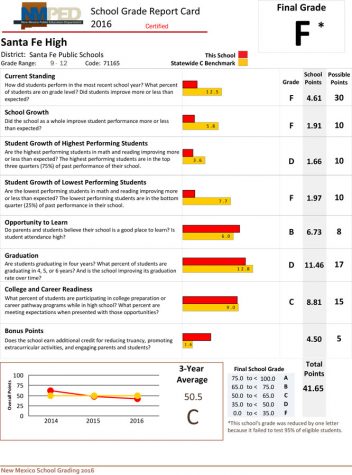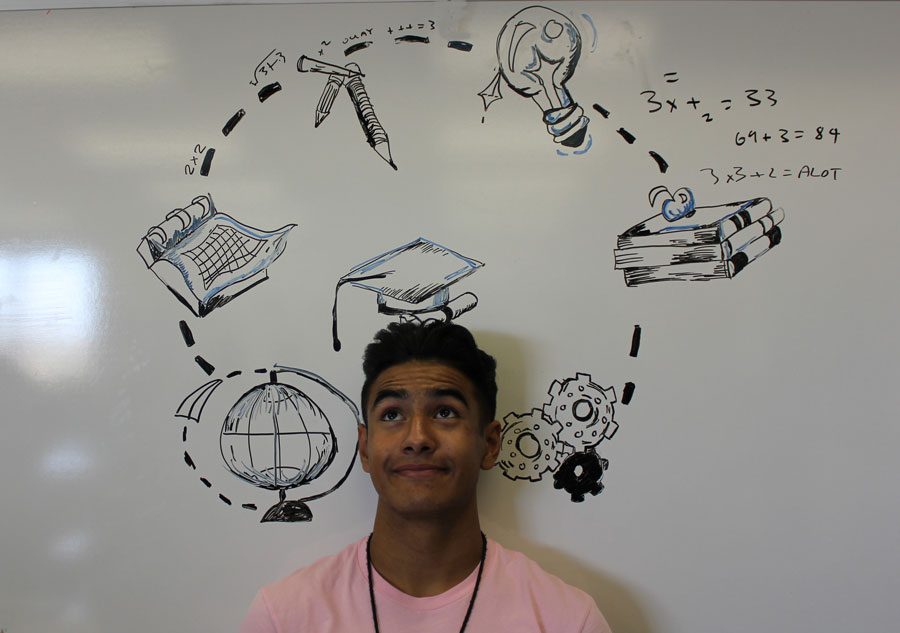Is SFHS a Failing School?
November 22, 2016
For the past two years, Santa Fe High has been rated an F school by the New Mexico Public Education  Department. But is this an accurate evaluation of our school?
Department. But is this an accurate evaluation of our school?
The evaluation is based on a combination of student achievement in English and math on standardized tests, growth on these tests over time, parent and student survey results, the graduation rate, and college and career readiness.
While the graphic accompanying this story shows all the detail, following is a breakdown of how schools are graded, based on a 100-point scale.
- Current Standing (standardized test scores, current year) — 30 points
- School Growth (improvement over previous years) — 10 points
- Student Growth of the Highest Performing Students — 10 points
- Student Growth of the Lowest Performing Students — 10 points
- Opportunity to Learn (determined by parent and student surveys) — 8 points
- Graduation (several measures) — 17 points
- College and Career Readiness — 15 points
- Bonus points for reducing truancy, promoting extracurricular activities, and engaging parents and students — 5 points possible
Clearly, test scores are an important factor in our school’s grade. These include the SBA, which measures science achievement; PARCC, which measures English language arts/literacy and math; and EoCs (end-of-course exams), which are meant to measure knowledge that should have been learned in a specific class. These scores are then compared to other schools within the state.
In 2014, when the SBA was the measure, 46 percent of students scored proficient in reading, and 38 percent scored proficient in math.
In 2015, when PARCC became the measure, reading-proficiency scores dropped by 12 percent and math-proficiency scores dropped by 21 percent, according to NMPED documents.
In 2016, with PARCC still as the measure, 7 percent of Santa Fe High students scored proficient in math, and 25 percent scored proficient in reading.
Although these tests are developed by educators, researchers, and others, many teachers and students believe they do not truly reflect students’ skills and knowledge.
“I believe that these tests are just one part of assessing what a student is capable of,” stated Mr. Marano, Santa Fe High’s directing principal. “I believe that students should be able to demonstrate their skills in numerous ways, such as a project, oral presentation, or hands-on assessment.”
Mateo Romero, a sophomore, stated, “These tests and observations seem to be all student capability is measured by. I believe that many more things should also be accounted for besides students’ testing abilities…. The attendance, academic grades, and especially the academic progress of students over many years should go into account for our school grade.”
Sophomore Brock McKinney claimed, “I do not think it is fair to base the school’s grade off of these tests because some kids get test anxiety and don’t have the proper skills for taking these tests. It really isn’t fair. Teachers also shouldn’t feel pressure to teach based off of standardized tests; they should teach what the kids will need to know. For me, that is college.”
What about the kids who are behind? The education received in elementary and middle school influences the success of students in high school. Many students who enter Santa Fe High do not have the skills they need for higher education.
Math teacher Mr. Tafoya stated, “We have many students who arrive with math deficiencies, like trouble with fractions, decimals, and dealing with positive and negative numbers when they enter this school.”
A senior who wished to remain anonymous said, “I know that when I was in tenth grade, I was shocked to find that most of the people in my honors English class didn’t even know what a noun was. Is it really fair to use their test scores to evaluate the academic strength of our school?”
So how should NMPED address this issue in its school grading system?
History teacher Carlos Caldwell offers a solution, stating, “I believe we need to know what kids know and what skills they have. I believe that is how we should measure growth — what a kid knows when they come into the class and what they are able to do when they leave.”
Mr. Tafoya said, “I don’t know how to fix it. Possibly to offer pre-algebra for students who are not ready for Algebra 1. Kids who don’t have these abilities like dealing with negative numbers and fractions bring down the average grade of the school.”
Sophomore Dylan Ramirez proposed, “Teachers should acknowledge the fact that many kids at this school are behind. I believe teachers should offer more opportunities for struggling students instead of letting them fall behind and drop out.”
Many programs are offered at Santa Fe High for struggling students: E2020 is a credit-recovery program for students who have failed a class; the Student Assistance Team offers interventions when a teacher observes that a student is falling behind; there are classes to help English language learners; the library is open Monday through Thursday until 5:30, with a teacher present to help students with their homework, and more.
In addition to academic help, there are programs to help students who are homeless or who need clothes or food. There are special environments for students with behavior issues, students with severe disabilities, and students who are medically fragile.
A 12th grade counselor, Ellen Smith, added, “We even have an attendance specialist at our school who calls students in if their attendance (or lack thereof) gets too extreme. Students who miss too much class fall behind, and this problem is now being addressed by trying to keep kids in class.”
Many students and teachers believe Santa Fe High’s grade does not accurately represent all that the school has to offer.
Sophomore Ella Nichols said, “Our school is definitely not an F. I know there are some classes that are not academically challenging at this school, but there are also lots of great electives like studio art, engineering and design, and bakery. The AP program is also very challenging. Kids who are willing to apply themselves can get a lot from going here. I know I am.”
With Santa Fe High’s extensive elective choices, nationally recognized AP program, 26 clubs — including National Honor Society, Key Club and SWAT — and programs such as AVID, many argue that Santa Fe High offers enough academic rigor and preparation for college and careers. However, in 2016, the NMPED rated Santa Fe High’s college and career readiness as a C. This evaluation is based on evidence that the students can pass a college level course, scores on college entrance exams such as ACT and SAT, and eligibility for an industry recognized certification, such as Prostart and other career technical education opportunities.
Junior Theo Goujon states, “Santa Fe High offers a wide variety of elective classes like computer science, advanced engineering classes, culinary classes. These classes are a great opportunity to really figure out what you really like and what careers you may like to one day pursue.”
Santa Fe High’s arts program allows students interested in visual arts, theater, dance, choir, band, orchestra, piano or guitar to practice and learn their craft in classes that include performance opportunities. Many students take advantage of these opportunities, which are often highly acclaimed. For example, in October, Santa Fe High’s production of Macbeth was featured on the cover of the Santa Fe New Mexican, and 15 choir and orchestra members won spots in prestigious All State ensembles.
“I hadn’t really danced before I started at Santa Fe High, and originally I was going to take dance as a PE credit,” says Claire Breitinger, a sophomore now in Dance 3. “But the dedication of the teacher, Donna Scheer, and the opportunities within the department actually ended up inspiring me to keep dancing. I think one of the best things about the dance department is that the students get to produce, choreograph, and perform in a dance performance every year, which is really creative and fun.”
The general consensus seems to be that Santa Fe High gives all students the opportunity to prepare for college and careers whether the NMPED recognizes it or not.
